| The Shrine of Remembrance set in park
lands, dedicated all those who have served in the Armed Services and
enlisted in Victoria. The monument comprises the Shrine and forecourt, a
post WWII conflict memorial, the Eternal Flame, Cenotaph and flagpoles.
Upon closing each day, the Last Post is played as the Australian flag is
lowered. The Shrine is a building listed on Heritage Victoria’s
Buildings of Significance Register. |
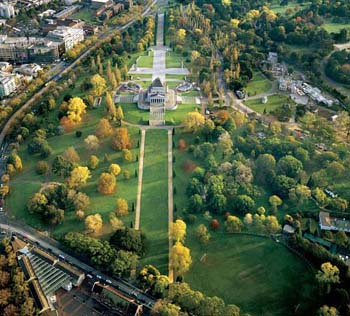 |
| A statue of Sir Edward
"Weary" Dunlop is made from bronze, granite and
metal spikes from the Burma-Thailand
railway in 1995 by Peter Corlett. Weary Dunlop was known as a
courageous leader and compassionate doctor, and showed great leadership
while serving as prisoner of war in Changi prison and on the
Burma-Thailand railway during World War 2. On the
steps leading to the sculpture are the names of other doctors who were
also POWs at Changi. |
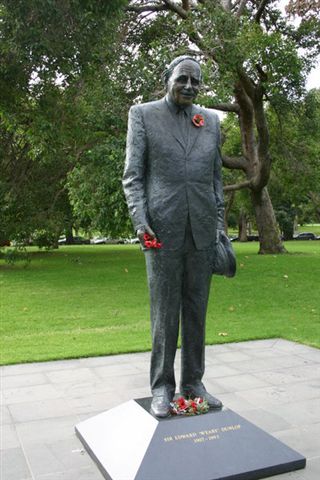 |
| A memorial to Sir John Monash,
as Commander in Chief of the Australian Forces during World War I, is
commemorated in a bronze equestrian statue created by Leslie William
Bowles. It was unveiled by His Excellence the Governor-General of
Australia, William
McKell on November 12, 1950. |
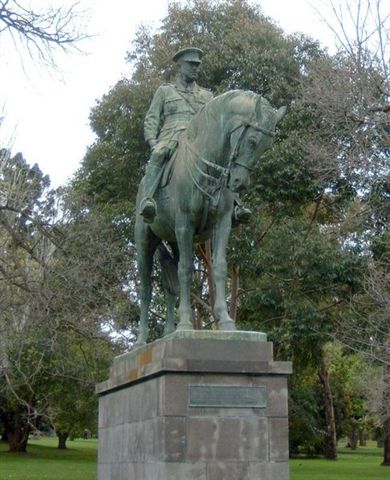 |
| A memorial statue of Sir Thomas Blamey
stands on the corner of Government House Drive and Linlithgow Avenue. It
was sculptored from granite and bronze by Raymond B. Ewers and presented
to the city in February 1960. It recognises Australia’s first Field
Marshall and his inistence to the British command that Australian forces
remain as cohesive units under Australian command. |
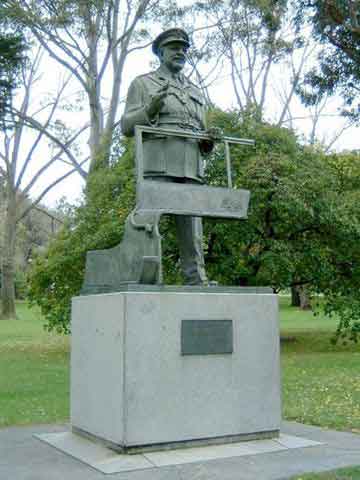 |
|
Nurse Edith Cavell Memorial. Edith Cavell was a Red
Cross Nurse working in Brussels during World War 1. She was involved in
helping British, French and Belgian soldiers to escape from enemy
occupied Belgium, to Holland and then on to their home countries. She
was arrested and tried by a German court who found her guilty of
assisting enemy troops to escape. A German firing squad executed her on
12 October 1915.
|
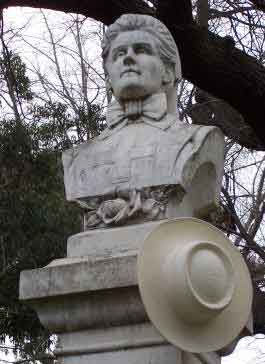 |
|
In Melbourne, the capital of the State of Victoria, in the lawn on
the western side of the Anglican Cathedral St Pauls, is a statue of
Flinders standing in his boat and being pulled ashore by two sturdy
sailors. The plaque reads:
Captain Matthew Flinders RN
(1774 - 1814)
Navigator
Erected by Public Subscription
1925
C. WEB GILBERT
SCULPTOR.
In this year of 2006, as thousands of Melburnians rush past this
statue each day, as they go about their business, I doubt many of them
would pause to remember the courage and achievement of that magnificent
master Navigator and Explorer, Matthew Flinders, and his Surgeon friend
George Bass.
Flinders standing in his boat and being pulled ashore by two sailors.
It was erected in 1925 and paid for by Public Subscription.
|
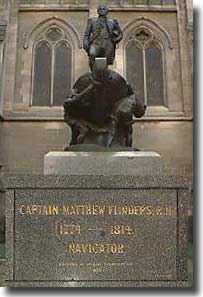
Flinders standing in his boat and being pulled ashore by two sailors.
It was erected in 1925 and paid for by Public Subscription.
|
|
Burke and Wills, two explorers who attempted to
cross the continent of Australia from south to north, and perished in
their attempt.
|
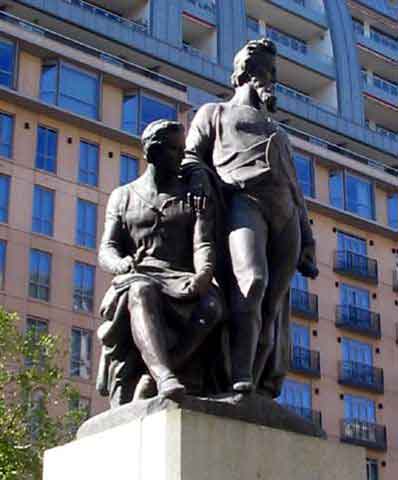
Burke standing, Wills seated.
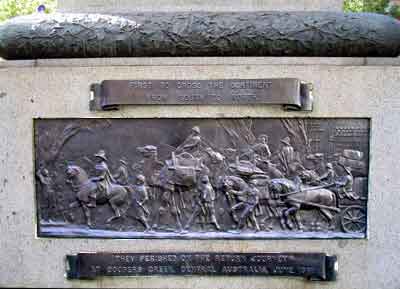
Front panel at the base of statue.The Expedition excitingly and
heroically sets off for the interior. There is much shouting of
"hurrah!" and throwing of hats into the air.
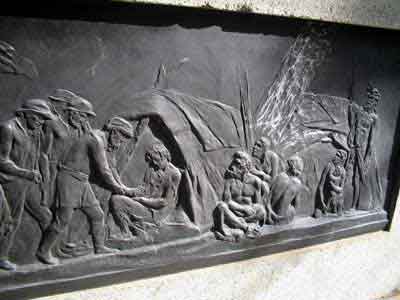
Right side panel - indigenous Australians attempt to assist the
Europeans.
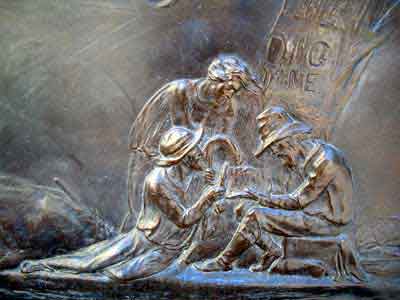
Back panel.: The Dig Tree, where things really went wrong.
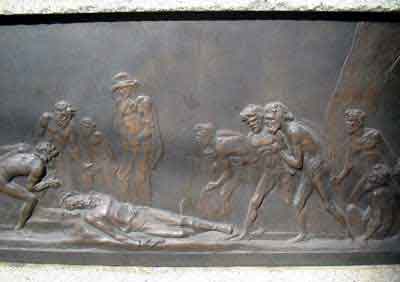
Left side panel: The discovery of Burke's remains. Hero but pitiful
failure.
|
|
The memorial in Melbourne General Cemetery consists of a massive granite slab. Around the four sides of the base are the following inscriptions:
IN MEMORY OF
ROBERT O'HARA BURKE
AND
WILLIAM JOHN WILLS
LEADER
AND SECOND IN COMMAND
OF THE
VICTORIAN EXPLORING EXPEDITION
DIED AT COOPER'S CREEK
JUN 1861.
COMRADES IN A GREAT ACHIEVEMENT
COMPANIONS IN DEATH
AND
ASSOCIATES IN RENOWN
THE FIRST TO CROSS
THE CONTINENT OF AUSTRALIA
BURKE
WILLS
GRAY
KING SURVIVOR.
|
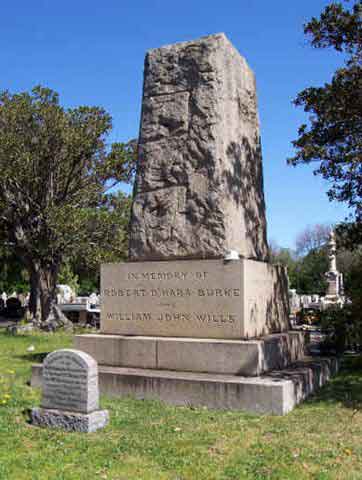 |
|
THIS MEMORIAL HAS BEEN ERECTED
TO MARK THE SPOT FROM WHENCE THE
BURKE AND WILLS
EXPEDITION STARTED ON THE 20TH AUGUST 1860
AFTER SUCCESSFULLY ACCOMPLISHING THEIR MISSION
THE TWO BRAVE LEADERS PERISHED ON THEIR RETURN
JOURNEY AT COOPERS CREEK IN 1861.
|
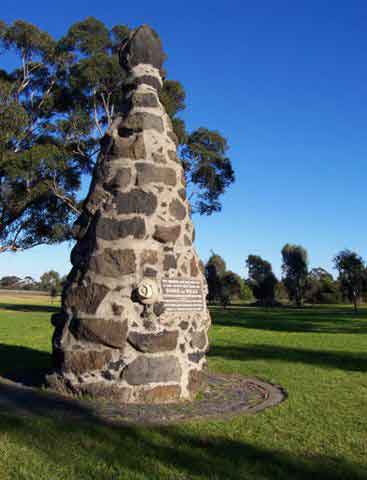 |
The Pathfinder, or Hammer Thrower without his Hammer.
Queen Victoria Gardens, Melbourne. |
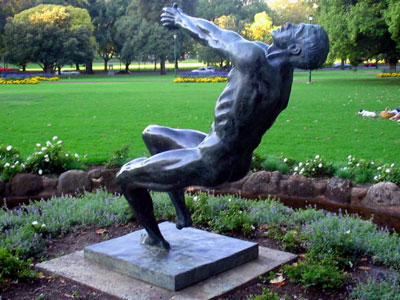 |
| The statues of John Batman and John Pascoe Fawkner and the monument on the corner of Market and Collins Street. |
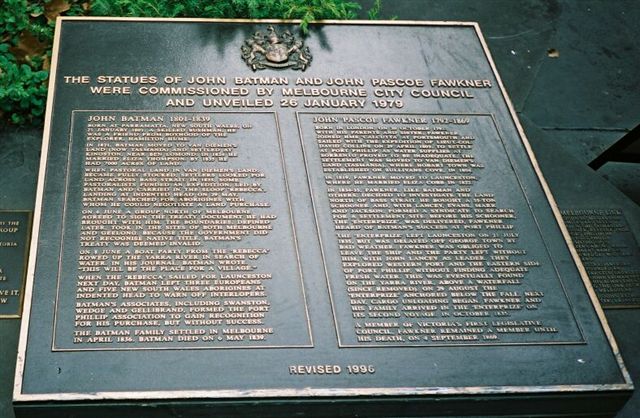
Plaque for Batman and Fawkner statues. |

John Pascoe Fawkner |
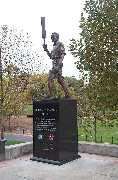
Memorial to John Batman at the Old Melbourne Cemetery site near the Queen Victoria Market.
|
|
John Pascoe Fawkner's Tombstone at the Melbourne Cemetery.
|

HERE LIES
THE MORTAL REMAINS OF
JOHN PASCOE FAWKNER
WHO FOUNDED THE CITY OF MELBOURNE
AUGUST 29TH 1835
BORN OCTOBER 20TH 1792, AT LONDON
DIED SEPTEMBER 4TH 1869, AT SMITH ST. COLLINGWOOD
AGED 77 YEARS.
ALSO OF
JOHN FAWKNER SENIOR
WHO DIED SEPTEMBER 24TH 1854
AGED 84 YEARS.
AND OF HIS WIDOW
ELIZA
WHO DIED MAY 18TH 1858
AGED 66 YEARS.
ALSO OF
ELIZA
WIDOW OF THE ABOVE
JOHN. P. FAWKNER
WHO DIED JULY 8TH 1879
|
| A sunken garden designed by Linaker was a special feature commemorating Victoria's pioneer women. A canal terminating in a blue tiled grotto, which contains Charles Web-Gilbert's small bronze figure of a woman provides the focus for this formal garden. |
 |
| The memorial, in the form of a drinking fountain, is a white marble cupola over a granite basin on a bluestone plinth on a two-stepped bluestone base. It is no longer in use as a drinking fountain bet there are still steps on the the south, east and west sides. |
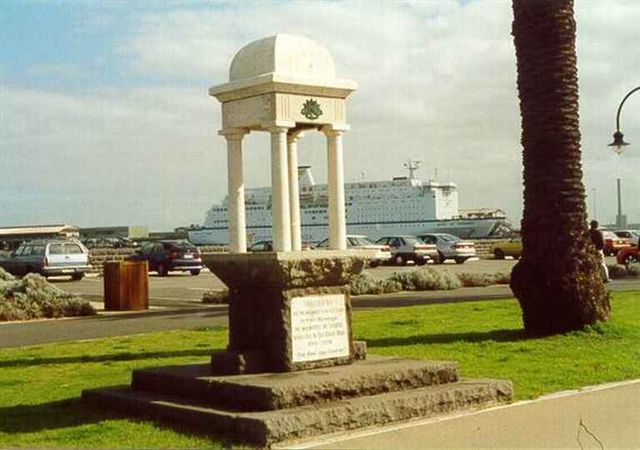
Marble tablet below
ERECTED BY
THE MUNICIPALITY AND CITIZENS
OF PORT MELBOURNE.
IN MEMORY OF THOSE
WHO FELL IN THE GREAT WAR
1914 - 1918.
FOR KING AND COUNTRY."
|
| On the corner of Linlithgow Avenue and St Kilda Road stands a bronze equestrian statue of Lord Hopetoun, more properly called John Hope, 1st Marquess of Linlithgow, also known as the first Governor-General of Australia. The statue is a result of a public subscription and was unveiled on June 15, 1911, by his Excellency Sir John Fuller, accompanied by Prime Minister, Billy Hughes. |
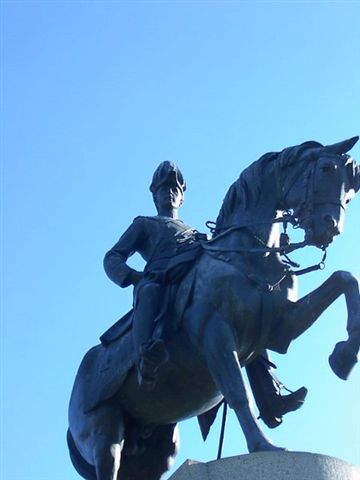 |
| The schooner 'Enterprize' is a replica of the ship purchased by John Pascoe Fawkner in 1835 to transport passengers, livestock and supplies from Tasmania. |
 |
Bronze statue of the great Australian cricketer, Sir Donald Bradman.
The statue depicts ‘The Don’ in familiar pose outside the Bradman Gate entrance to the Great Southern Stand. The likeness is uncanny. |
 |
|
Australia’s Golden Girl, Betty Cuthbert, has been immortalised in bronze at the MCG.
Her statue, positioned on the Great Southern Stand concourse near the Bill Woodfull Gate.
The Louis Laumen work is magnificent, capturing Cuthbert in full stride with mouth agape as she hurtled to victory in the 100 metres at the 1956 Olympics in Melbourne. It is the second of 10 statues commissioned as part of the Tattersall’s “Parade of the Champions” project, a $1 million gift to the people of Australia.
|
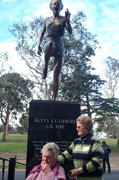 |
| Simpson and his Donkey outside the Shrine of Remembrance Melbourne. |
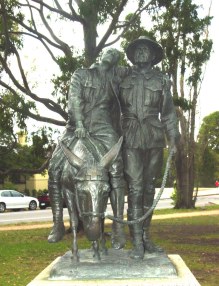 |
























